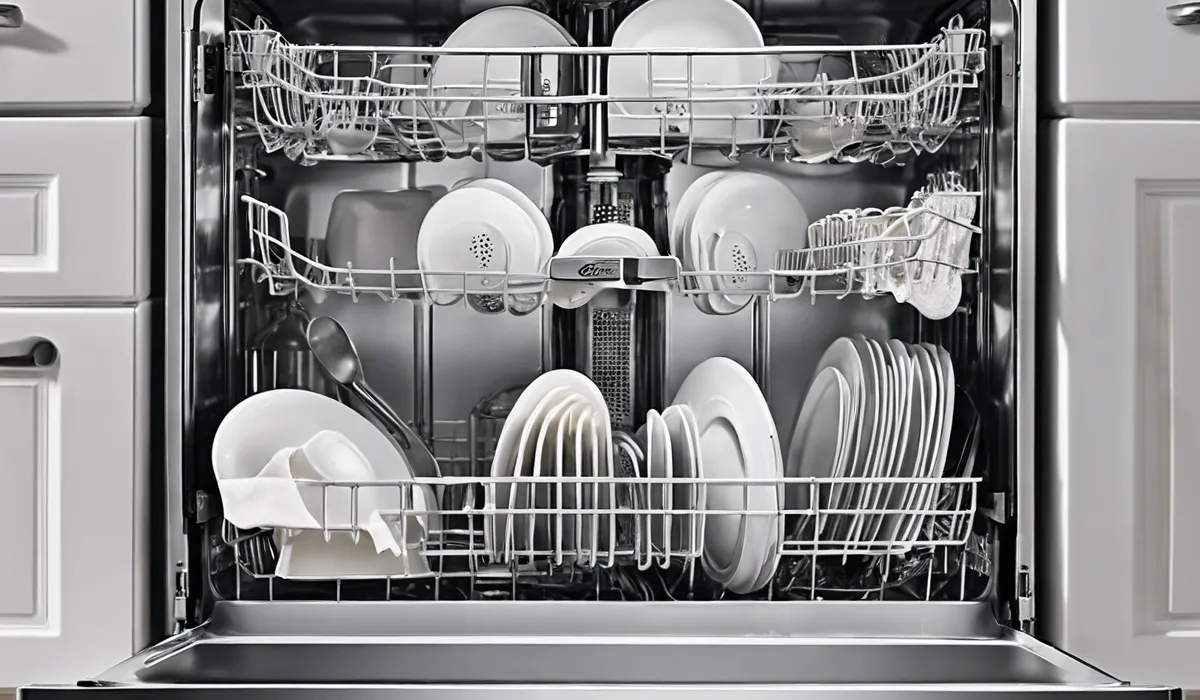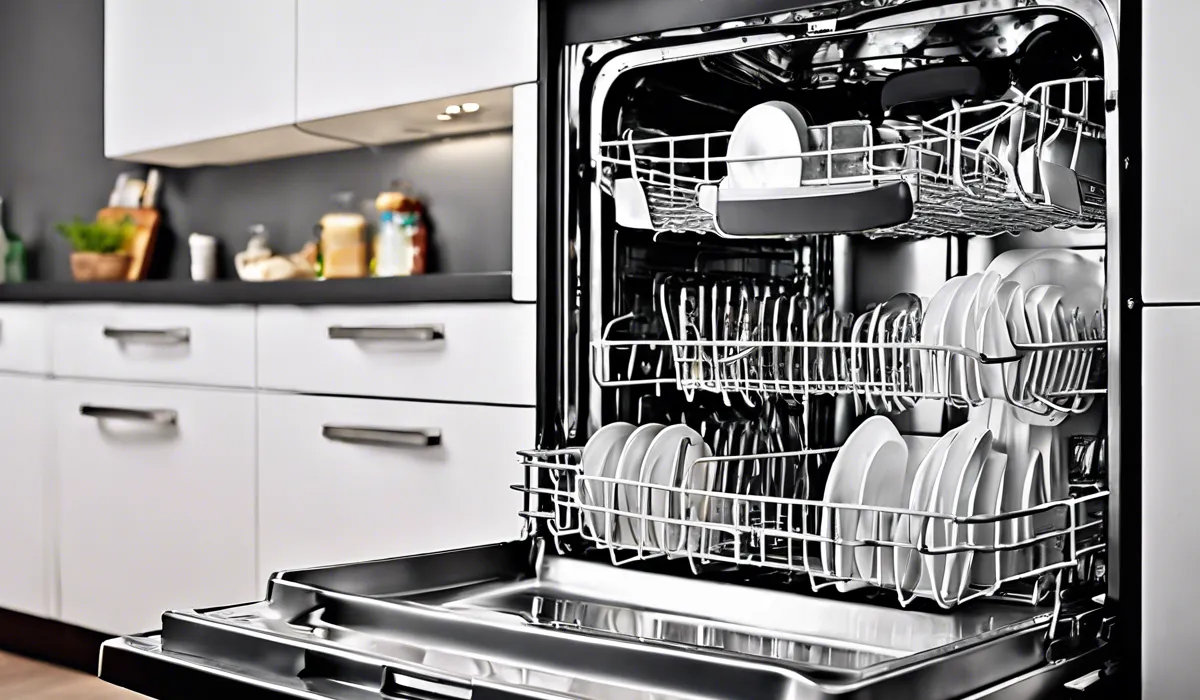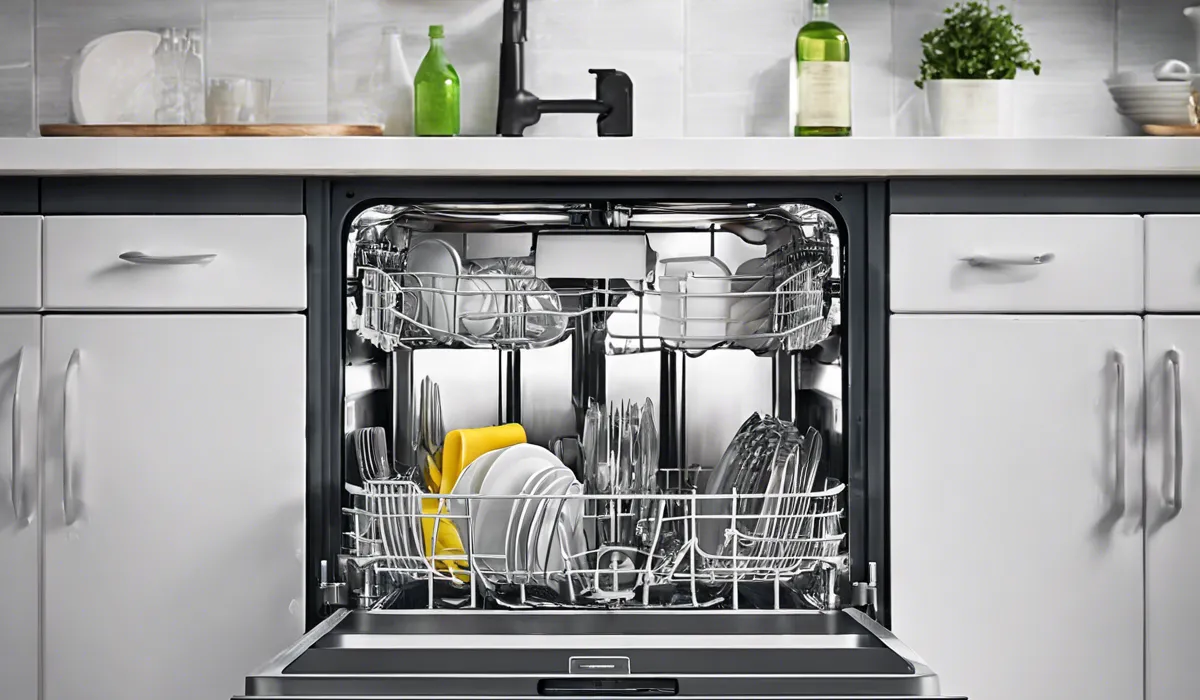How to Clean a Dishwasher with Vinegar: A Sparkling Finish!
To clean a dishwasher with vinegar, fill a dishwasher-safe cup with white vinegar, place it on the top rack, and run a hot water cycle. Vinegar helps remove grease and odors, leaving your dishwasher fresh and clean.
Preparing Your Dishwasher for Cleaning

Removing Items and Inspecting the Interior
Before the cleaning process begins, it’s essential to prepare your dishwasher. Start by taking out all dishes, glasses, utensils, and any other items.
This leaves the dishwasher empty and ready for a thorough cleaning. Look closely at the interior space, noting any spots that might need extra attention later on.
This step is crucial for ensuring that the cleaning agents, like vinegar in this case, can reach all surfaces without obstruction.
Cleaning the Dishwasher Filter
The dishwasher filter is a common place for food particles and debris to accumulate.
Locate the filter, usually found at the bottom of the dishwasher. Carefully remove it according to the manufacturer’s instructions.
Rinse it under warm water and gently scrub it with a soft brush to get rid of any trapped particles.
This helps to prevent clogs and ensures that water can flow freely during the cleaning cycle. Return the clean filter to its rightful place before proceeding.
Wiping Down the Door and Gasket
With a damp cloth, wipe down the inside of the dishwasher door, paying special attention to the edges and corners where grime can build up.
The rubber gasket, which forms a seal when the door is closed, is also prone to collecting residue.
Gently clean around the gasket to remove any food particles or grease. This not only helps in preventing odors but also maintains the effectiveness of the seal, preventing leaks during operation.
Using Vinegar to Clean Your Dishwasher

Filling a Container with Vinegar
To harness the cleaning power of vinegar, fill a dishwasher-safe bowl or glass with white vinegar.
The acidic nature of vinegar makes it excellent for dissolving grease and removing odors without harming your dishwasher’s interior.
Be sure to use enough vinegar to be effective during the cleaning cycle—typically a cup or two is sufficient.
Placing the Vinegar on the Top Rack
Take the container filled with vinegar and place it securely on the top rack of the empty dishwasher.
Positioning it on the top rack ensures that during the wash cycle, the vinegar will disperse evenly throughout the dishwasher, reaching all the nooks and crannies where grime tends to hide.
Running a Hot Water Cycle
With the vinegar in place, set your dishwasher to run on the hottest water cycle available.
Hot water aids the vinegar in breaking down any buildups of fat, soap scum, or food remnants. It’s important to run the dishwasher empty, except for the vinegar, to ensure that nothing obstructs the cleaning process.
This cycle will leave the dishwasher’s interior sanitized, fresh, and ready for use.
After the Vinegar Cycle

Inspecting the Dishwasher Post-Cleaning
Once the vinegar cycle is complete, open the dishwasher and inspect the interior. Take a moment to look for any areas that might still have mineral deposits, stains, or buildup.
The vinegar and hot water should have helped to loosen and remove most of the debris, but some spots can be stubborn and may require a bit more attention.
Cleaning Remaining Trouble Spots
If you find any remaining trouble spots, dampen a cloth or sponge with a bit of warm water and wipe them away. You might need to apply a little elbow grease for tougher stains.
For extremely persistent areas, a soft-bristled brush can be used to gently scrub without scratching the dishwasher’s surfaces.
Be thorough but gentle to maintain the integrity of your dishwasher’s interior.
Running a Final Rinse Cycle
After you’ve addressed any remaining spots, it’s time to run a short rinse cycle. This will wash away any residual vinegar and the last of the loosened debris.
Once this cycle is finished, your dishwasher will not only be clean but also smell fresher and operate more efficiently.
Regular maintenance like this extends the life of your appliance and ensures that your dishes come out spotless every time.
By following these simple steps and using natural, inexpensive vinegar, you can maintain a clean and functional dishwasher with minimal effort.
Not only does this routine save money on expensive chemical cleaners, but it also supports a healthier home environment by reducing the use of harsh substances.
A clean dishwasher is an efficient dishwasher, and with these tips, you’ll be able to keep yours in top condition.
FAQs About Cleaning Dishwasher with Vinegar
What type of vinegar should I use to clean my dishwasher?
You should use white vinegar to clean your dishwasher, as it is effective at removing grease and odors.
How do I place the vinegar in the dishwasher for cleaning?
Fill a dishwasher-safe cup with white vinegar and place it on the top rack of your dishwasher before running a cycle.
Which dishwasher cycle should I use with vinegar for cleaning?
Run a hot water cycle with the vinegar in the dishwasher for optimal cleaning results.
Do I need to add detergent when cleaning my dishwasher with vinegar?
No, you should not add detergent when cleaning your dishwasher with vinegar; the vinegar alone will do the job.
How often should I clean my dishwasher with vinegar?
It’s recommended to clean your dishwasher with vinegar once a month to maintain its performance and freshness.
Final Thoughts
Cleaning your dishwasher with vinegar is an effective and simple process. By placing a cup of white vinegar on the top rack and running a hot water cycle, you can effortlessly cut through grease and eliminate unpleasant odors.
This method ensures your dishwasher remains fresh and maintains optimal performance.
Useful Resources
- https://blogs.extension.iastate.edu/answerline/2016/03/21/cleaning-your-dishwasher/
- https://www.cdc.gov/healthypets/keeping-pets-and-people-healthy/cleaning-and-disinfecting-pet-supplies.html
- http://www.fsis.usda.gov/food-safety/safe-food-handling-and-preparation/food-safety-basics/washing-food-does-it-promote-food





